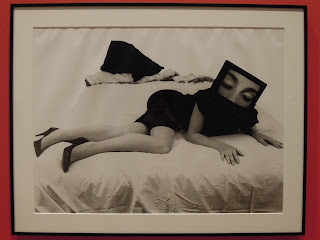The Deconstructive Impulse - Women Artists Reconfigure the Signs of Power 1973-1991.
The Contemporary Arts Museum Houston in Houston, TX
During spring break, I went to The Contemporary Arts Museum in Houston. It was a small museum compared to other national arts museums, but the exhibit was great. Especially the topic of the exhibit of women images in media worked by women artists, so I was glad of this becuase I am taking women studies class in this semester. I want to introduce some works of art of that exhibit. Before I expalin my experience, the following paragraph is the official introduction in the website of the museum.
http://www.camh.org/exhibitions/deconstructive-impulse-women-artists-reconfigure-signs-power-1973-1991
The Contemporary Arts Museum Houston is pleased to present The Deconstructive Impulse: Women Artists Reconfigure the Signs of Power, 1973-1991, a survey of leading women artists that examines the crucial feminist contribution to the development of deconstructivism in the 1970s and ’80s. As the term suggests, deconstructivism involved taking apart and examining source material, generally borrowed from the mass media, to expose the ways commercial images reveal the mechanisms of power. Women had a particularly high stake in this kind of examination and were disproportionately represented among artists who practiced it. This exhibition is organized by Neuberger Museum of Art, Purchase College, State University of New York.
As I said, even though most works of art were excellent, I would like to introduce some them. I could take pictures of these works of art under the permission.
Anonymous Artists
Do Women Have to be Naked to Get into the Met. Museum? 1989 (Poster)
The Advantages of Being a Woman Artist, 1988 (Poster)
Top Ten Signs that You’re an Art World Token, 1995 (Poster)
The first arts piece of art is a series of posters. At first sight, I stopped in front of this. It was really interesting to present a woman as a Guerrilla. The artists asked if women should be treated as a naked object of arts work. This reminded me of the fact that images of women are portrayed as naked or exaggerated sexual images in works of art even masterpieces. Some say that the reason for using the body shape of women in art is because they are more beautiful than men’s bodies. Well, at first I think that it’s a kind of excuse because some artists just focus on the sexuality to get attention from audiences instead of ‘real beauty.’
Lynn Hershman (American, born 1941)
Seduction from “Phantom Limb,” 1988
TV Legs from Phantom Limb,” 1990
These works by Lynn Hershman show media images of women. According to information from websites about her and her works, Hershman focused on the relationship between human and technology. As their titles, in many media content, women characters allure their audience using their images of bodies. Sometimes, the images exaggerate the body parts such as legs and boobs, and media continue reproduction of these images with variations. As we discussed in the gender class, this segmented women’s body images use in especially advertisings and even television shows.
Deborah Kass (American, born 1952)
Before and Happily Ever After, 1991
I was impressed by this picture. I laughed at this picture at sight. How humorous and witty! Most princesses of fairy tales are beautiful even though sometimes they are in poor positions such as Snow White and Sleeping Beauty. Princes fall in love with them at sight, and everything changes. Women’s futures, even in cases of princesses, are up to the princes’ choices and decisions. Of course, their choices come from the beauty of princesses. I want to believe these days are different to the past, unfortunately I cannot be sure about it. Turn on television, and you can look at modern princesses, who will do anything to meet their princes.
As I mentioned above, it was a good experience to see what I learned in classroom through works of art. I would like to recommend to go this exhibit. The good thing is that it is free.













